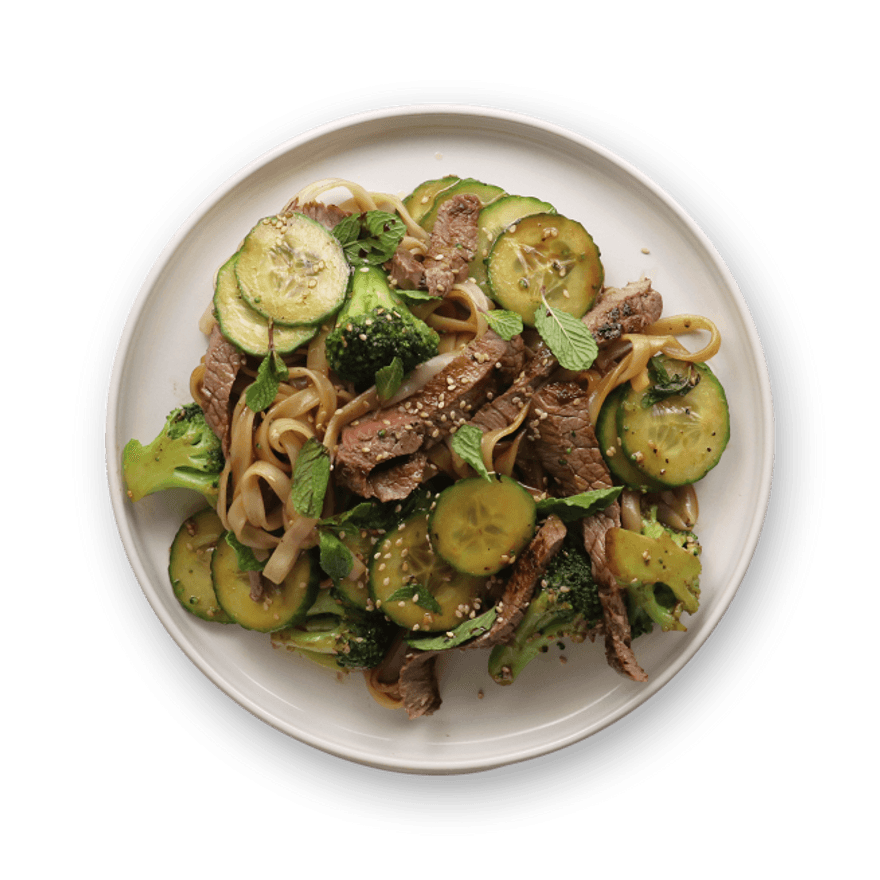Ingredients
Utensils
Stovetop, Pot (small), Frying pan
recipe

Step 1
Cook or soak the rice noodles according to the package instructions.

Step 2
Meanwhile, thinly slice the cucumber and set aside.

Step 3
Wash the broccoli and cut it into florets.

Step 4
Cook the broccoli in a pot of salted boiling water for 5 minutes, or until crisp-tender.

Step 5
Drain the rice noodles and rinse them under cold water.

Step 6
Drain the broccoli and rinse under cold water.

Step 7
Heat a drizzle of oil in a pan over high heat. Add the beef and cook for 1 minute.



Step 8
Flip the beef. Add the soy sauce, balsamic vinegar, and sugar to the pan and cook for 1 more minute.
Step 9
When the beef is done, remove it from the pan and let the sauce continue to cook, until it reduces a bit.

Step 10
Slice the beef into strips.


Step 11
Place the noodles, cucumber, broccoli, mint leaves, and sesame seeds in a large bowl. Add the sauce, season with pepper and mix to combine.

Step 12
Serve the noodle salad on a plate with the beef, a few more mint leaves and sesame seeds — it's ready!
Personal notes
Add your own flavor!
Nutrition facts
Average estimated amount for one serving
| Energy | 449 cal. |
| Fat | 5 g |
| Carbohydrates | 64 g |
| Protein | 36 g |
| Fiber | 4 g |
Values are based on an average estimate for one serving. All nutrition information presented on Jow is intended for informational purposes only. If you have any concerns or questions about your health, please consult with a health-care professional.
On average, one serving of the recipe "Asian-Style Noodle Salad with Beef" contains 449 Energy, 5 g of Fat, 64 g of Carbohydrates, 36 g of Protein, 4 g of Fiber.
Price per portion
| € | Nos recettes à -2 € par portion |
| €€ | Nos recettes entre 2 € et 4 € par portion |
| €€€ | Nos recettes à +4 € par portion |
Please note, the price above is dependent on your grocer and the available products in the grocery store you chose.
Scores


A Nutri-score
The Nutri-score is an indicator intended for understanding nutritional information. Recipes or products are classified from A to E according to their food composition to promote (fiber, proteins, fruits, vegetables, legumes, etc.) and foods to limit (energy, saturated fatty acids, sugars, salt, etc.).
D Green-score
The Green-score is an indicator representing the environmental impact of food products. The recipes or products are classified from A+ to F. It takes into account several factors on the pollution of air, water, oceans, soil, as well as the impacts on the biosphere. These impacts are studied throughout the product life cycle.
Retrieving reviews...



